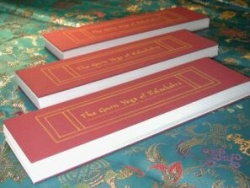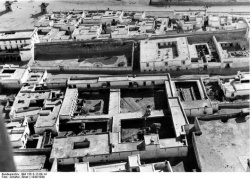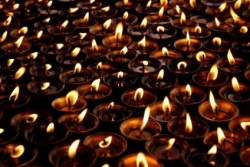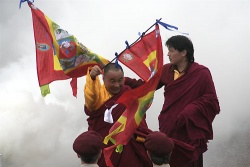Tibetan Buddhism unbounded - The Zimwock Rinpoche lineage by Dr. Pauline Gallagher & Venerable Freeman Trebilcock
Very little is known in English about the Zimwock (Zimwok, Zimog)Rinpoches, a lineage of remarkable teachers and meditation masters from Nalandra (Nalendra) Monastery in central Tibet. Yet they have had quite a profound influence on all four main traditions of Tibetan Buddhism since the 16th century when the lineage began.
The 6th Zimwock Tulku Rinpoche came to Australia in December 2008 to take up the position of resident teacher of Jamchen Buddhist Centre. In three years he has transformed this small but active centre in the eastern suburbs of Melbourne, and is strengthening the teaching and practice of Vajrayana in Melbourne. In the spirit of his predecessors, he is challenging conventions and reaching out to all sentient beings – Tibetan Buddhism unbounded.
The 6th Zimwock Tulku was born ina refugee camp in Manali in Northern India. His father was Dzongsar Gang-naTulkuRinpoche, who was a highly respected Rime lama, in exile from Dzongsar Monastery in Kham. The Rime approach Zimwock Rinpoche is considered to be an emanation of the future Buddha Maitreya. He was recognized by His Holiness Sakya Trizin, head of the Sakya school of Tibetan Buddhism, and endorsed by many high lamas including HH 14th Dalai Lama, HH 16th Gyalwa Karmapa, Ling Rinpoche and Trijang Rinpoche. His recognition was significant.
As a young monk, he was given the best education possible at that time, first with his father and his personal tutor, Lama Trinle Choedak, and then at Sakya College in Dehra Dun in Northern India. The Sakya school of Tibetan Buddhism has only three branches – Sakya, Ngor and Tsar. The Zimwock Rinpoches were the holders of Tsarpa.
The Tsarpa branch was famous for maintaining all the highly prized uncommon or most esoteric meditation lineages of the Sakya school. The principal monastery of the Tsarpa branch was Nalandra Monastery in the Phenpo Valley, where the Zimwock Rinpoches were one of only two throne-holders. So his education was very important. The other throne-holder the 18th Chogye Trichen Rinpoche, passed away in 2007. Zimwock Rinpoche is the most senior lama of the Tsarpa branch alive today.
Nalandra was largely destroyed by the Chinese military in 1959.The Red Guards completed its destruction in 1966 when they burned down the huge Tsokchen assembly hall and other remaining colleges and residences. It has undergone extensive rebuilding in recent years.
Currently there are about 70 monks in residence. Before 1959, there were about 600 and at its peak in the early years it housed over 2000 monks. It was one of the larger and most important Sakyapa monasteries in Tibet.
Nalandra Monastery was established in 1425 by the Sakya master Rongton Sheja-kunrig, a contemporary of TsongKhapa, with the help of his disciple Dakpo Tashi Namgyal. It was named after the famous ancient Nalanda University near Rajgir in India.
Tashi Namgyal was famous as an extraordinary teacher and Mahamudra meditation practitioner. It is said that he taught as many as thirty-two teaching sessions a day from heart, without using any texts. When Rongton passed away, Tashi Namgyal became Abbot of Nalandra, but it is understood he didn’t stay in the job very long. He appointed GewaGyatsen as throne holder and gave him Rongton’s residence. He then established a new residence for himself below Rongton’s house. Since then this has been known as Zimwock, meaning ‘lower house’, a contraction of zimkhang (house) and wok (lower).
It was Tashi Namgyal who caused the expansion of Nalandra such that it became the home for the greatest Sakya philosophical colleges in Tibet. He went off in later years and spent time as the chief abbot of Daklha Gampo monastery in southern Tibet – a monastery of the Kagyu school of Tibetan Buddhism which was the main Kagyu centre for Mahamudra study and practice in Tibet. In his later life, Tashi Namgyal became more well-known and revered by the other schools of Tibetan Buddhism than in Sakya. They valued him so highly because his teachings and writings came from his own experience as a practitioner. As Thrangu Rinpoche described it “… the words of Dakpo Tashi Namgyal are unique in that they are adorned with plenty of pithy advice out of his personal experience. … His methods for practicing Mahamudrad in books such as ‘Moonbeams’ and ‘Clarifying The Natural State’, are preeminent.”
Nevertheless, much of what we know about Tashi Namgyal and his reincarnations has come from an account written down by Lama Trinle Choedak, the personal tutor of the 6th Zimwock Rinpoche. There is very little in contemporary literature about the Zimwock Rinpoches, even about Tashi Namgyal. Even though much was lost when Nalandra was destroyed, there may still be some historic documents and records in Phenpo to reveal why they were held in such high esteem.
What we do know is that the Zimwock Rinpoches were outstanding teachers and yogis and their teachings and practices were not confined to Sakyapa.
The first Zimwock Tulku, Ngawang Norbu, had the title ‘Shabdrung’ which is an honorific only given to the great lamas in Tibet.
The second Zimwock Rinpoche, Ngawang Sangye Tenzin, completed retreats on many supreme deities and became a widely celebrated master in the two stages of meditation.
The third Zimwock Rinpoche, Ngawang Tenzin Trinle (1744-1798), was said to be an excellent scholar in all fields, could remember his past lives and whatever he did, he was never moved from his stabilization in clear light meditation. He apparently also produced many writings, including a Guru Yoga practice of Padmasambhava. Tenzin Trinle was the first to transmit the Sakya Vajrayogini lineage to the Gelugpa school.
The fourth Zimwock Tulku, Jampa Ngawang Tenzin Nyendrak (1799-1884) was also a brilliant scholar and meditator. A student of Jamyang Khyentse Wangpo and Patrul Rinpoche, he became a teacher of the 12th Dalai Lama and the 7th Panchen Lama. It is said he had many protector deities as his companions and at his disposal whenever he needed them. He was famous also for his expertise in Tibetan medicine and literature and spent time as professor of medicine, poetry and Tibetan Buddhist Literature at Chakpori Medical College in Lhasa – the pre-eminent centre in Tibet for medicine.
It is believed he had 5 emanations after his death. The fifth Zimwock Rinpoche, Kunga Tenzin, was Tenzin Nyedrak’s body emanation.
Kunga Tenzin (1884-1964) was said to spend most of his time in retreats on the major meditational deities, yet he still managed to study with great teachers such as the 13th Dalai Lama and teach all the major Sakya teachings as well oral transmissions of the Kangyur and Tengyur. Many thought him to be an emanation of Mahakala, the king of the Dharma protector deities. He was one of only three holders of the eminent title of Vajradhara, awarded by the Tibetan central government. He was the guru of the 18th Chogye Trichen Rinpoche, also of Nalandra, who was considered the definitive authority on Kalachakra and was a teacher of the 14th Dalai Lama.
Fifth Zimwock Rinpoche was quite elderly when he escaped from Tibet in 1959 into Nepal and then to India. Before he passed away in Dharamsala, he became the guru of two of the gurus of the 14th Dalai Lama, Ling Rinpoche and Trijang Rinpoche. He also passed the Vajrayogini lineage to Gelugpa and was highly revered by all including many from the great Gelugpa monasteries of Sera, Ganden and Drepung.
Such was his spiritual greatness that his stupa is made if gold and precious gems.
Even though they were firmly rooted in the Sakya sect, the Zimwock Tulkus had taken a non-sectarian (Rime) approach to Buddhism. They were not bounded by their tradition but sought to learn and to help others learn, to spread the Dharma in the most effective ways available to them. All of them were monks, all of them lived at Nalandra Monastery - up to the 6threincarnation.
The Tulku system of recognised reincarnate lamas was a useful mechanism for ensuring throne-holders in Tibetan monasteries. This is what happened to Nalandra monastery and its two throne-holders escaped over the High Himalayas into exile. The 6thZimwock Rinpoche (Ngawang Tenzin Trinle Norbu) was one of the first reincarnate lamas recognized and enthroned in exile from Tibet. With no monastery and no country, what’s a new tulku to do? To do all the things he couldn’t do in a monastery, of course!
After years of study and academic achievement at Sakya College, Zimwock Rinpoche set aside his monastic vows and went to live first in Kathmandu Nepal, then Dharamsalain India, then in Switzerland. He studied and taught Tibetan language, he worked in a factory. He married, had a family. By the time he came to Melbourne with his family at the end of 2008 and began to teach the Dharma, he had acquired a wealth of life experience to enrich his teachings.
Jamchen Buddhist Centre (Chogye Jamchen ChoeDzong – Chogye Fortress of Loving-Kindness) was a small but established Sakyacentre in the Melbourne suburb of Balwyn without a resident teacher. Its patron was ChogyeTrichen Rinpoche (hence the name) until his passing in 2007. This Australian living room is now the seat of Tsarpa.
Zimwock Rinpoche began to teach. He set up weekly sessions on texts from the great masters, including Shantideva, Nagarjuna and Atisha and monthly introductory Dharma talks. He began to lead meditation practices, not the usual techniques but his own development of ancient techniques.
He started to offer initiations, first peaceful ones (Medicine Buddha, Manjushri, 21 Taras) but also Mahakala. Protector empowerments of this nature are hardly ever offered in the west. Now Jamchen holds an annual three-day Mahakala puja immediately after Christmas, to bring benefit for the year ahead.
He also started teaching Tibetan language and connecting with the Tibetan community in Victoria. They hold him in high respect. Since he arrived in Melbourne, Traleg Kyabgon Rinpoche has scaled back activities at his Carlton centre (Kagyu E-Vam Buddhist Centre) and the much-loved GesheLoden of the Tibetan Buddhist Society at Yuroke passed away. More and more the Tibetan community is focusing on Zimwock Rinpoche.
In 2010, Jamchen and the Tibetan community held a major fundraiser, the Snow Lion Relief,which was a celebration of Tibetan culture across the different countries of the Himalaya.
Half the profits went to help the people of Ladakh and Tibet after disastrous mudslides caused great loss of life and damage in August 2010. The downpours that caused these mudslides were also responsible for the great floods lower down the Indus in Pakistan.
In the multi-cultural, multi-faith environment of 21st century Melbourne, the 6th Zimwock Rinpoche is taking Rime movement sensibilities much wider. He was a popular chair of the Melbourne celebration of the 2010 United Nations Day of Vesak, which brought all Buddhist vehicles together. In 2011 they invited him back to give the dedication.
With unbounded respect for the wisdom of other schools and traditions, he is hosting a Rime series of visiting teachers at Jamchen, and contrary to tradition, he staysto hear their teachings. So far, he has welcomed Venerable ThichPhuoc Tan, the Abbot of the Vietnamese Quang Minh Temple in Braybrook Victoria, and KhenpoNgawangDhamchoe, a Sakya friend from Drogmi Buddhist Institute in Sydney. Khenpo is a very distinguished teacher yet he would not normally teach in the presence of a Rinpoche who is higher in the spiritual hierarchy than himself.
He respects and seeks to learn from the other faiths. In September 2011 on St Michael’s Day he was invited by St Michael’s Uniting Church in Collins Street Melbourne to give the blessing at their Ceremony of the Rocks – a universal blessing to the world. The Minister of St Michael’s is Dr Francis McNab, an internationally renowned Christian theologian. It is likely that they will have more interaction and exchange beyond the spirit of inter-faith.
The truth lies everywhere. So the approach of non-sectarian or “unbounded” Buddhism will continue to be very important to the growth and spread of Tibetan Buddhism in the West. To have a lineage holder such as the Zimwocke Rinpoche’s residing in Australia, giving the highest teachings is both rare and a significant step forwards in this movement. Where it will go from here we can only wait and see.
=
Source
=
- ChogyeTrichen Rinpoche, ‘The Biography of ChogyeTrichen Rinpoche'in ‘Parting from the Four Attachments’ (2003), Snow Lion Publications. ISBN 1-55939-193-6
- Alexander Berzin, ‘A Brief History of Nalendra Monastery’ (2003)http://www.berzinarchives.com/web/en/archives/study/history_buddhism/buddhism_tibet/sakya/brief_history_nalendra_monastery.html
- David P. Jackson,‘The Early Abbots of ‘PhanpoNalendra: The Vicissitudes of a great Tibetan Monastery in the 15th Century’ (1989), Wein, Austria.
- DakpoTashiNamgyal, ‘Mahamudra The Moonlight – Quintessence of Mind and Meditation’ (Translator’s Introduction), 2nd edition translated and annotated by Lobsang P. Lhalungpa, Wisdom Publications 2006, ISBN 0-86171-299-4.
- ThrangoTulku, (2001) Introduction to: DakpoTashiNamgyal, ‘Clarifying the Natural State’, RangjungYeshe Publications 2001, ISBN 962-7341-45-2.
- TrinleChoedak, ‘ZimwockTulku Lineage’, English translation by Lama Choedak Rinpoche (2008) (unpublished).
Acknowledgements
The authors wish to acknowledge Zimwock Rinpoche for permission to reproduce the only known photograph of the 5thZimwock Rinpoche and the photo of the throne-holders of Sakya, Barry Flaming:Photography (barryflamingblogspot.com/2006) for his beautiful photographs of Nalandra Monastery, Neil Madden for his photographs of the Zimwock family and the Tibetan group at Losar 2011 and Lama Choedak Rinpoche for his translation of Lama TrinleChoedak’s account of the ZimwockTulku Lineage.
The authors thank all those who have provided information for this presentation. We recognise that there may be errors in our compilation and acknowledge that it is us who may have erred. We pray that future researchers will benefit from this account and not be mislead by any of our inaccuracies. We dedicate any merit from this work to the benefit of all sentient beings.
Source
Author: Dr. Pauline Gallagher & Venerable Freeman Trebilcock
buddhismandaustralia.com




